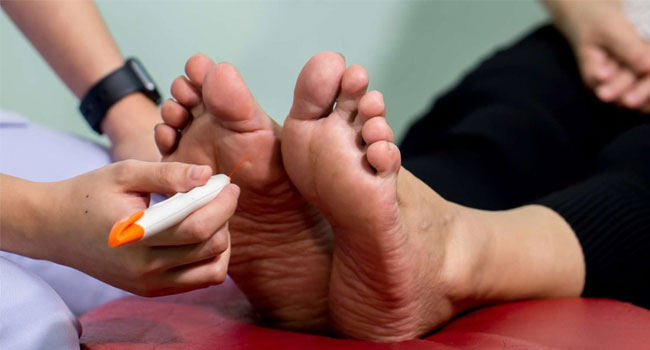An EMG/NCV (Electromyography/Nerve Conduction Velocity Study) is the most accurate and exact test for diagnosing Neuropathy and developing a list of potential causes. It is essential for Confirmation of the diagnosis.
What Causes Neuropathy?
Diabetes is the leading cause of peripheral neuropathy globally. Other medical disorders and drugs may also induce neuropathy. In certain situations, no cause can be found, which is known as idiopathic neuropathy. Diabetic polyneuropathy refers to peripheral neuropathy induced by type 1 diabetes (Juvenile Onset) or types 2 diabetes (Adult Onset). It’s most likely caused by excessive glucose levels in your blood, which damage the small blood vessels that nourish your nerves. The longer you have diabetes, the more likely you are to develop peripheral neuropathy. Nerve injury causes discomfort in up to one out of every four patients with the illness.
EMG/NCV confirm the Peripheral neuropathy diagnosis
A neurological testing expert will perform nerve tests such as:
Nerve Conduction Velocity (NCV) test – in which small metal wires called electrodes are put on your skin, causing tiny electric shocks to activate your nerves; the speed and intensity of the nerve signal is monitored.
Electromyography (EMG) is a technique that involves inserting a small needle through your skin into your muscle and measuring the electrical activity of your muscles. NCS and EMG are often performed together.
Children and adolescents, in contrast to adults, frequently exhibit minimal signs or symptoms of neuropathy early in their disease; thus, clinical examination is less sensitive and specific than nerve conduction studies (NCSs), which serve as the gold standard test in detecting subclinical neuropathy.
NCS is noninvasive, standardized, and objective, and the most useful electrodiagnostic test for assessing the dysfunction of large myelinated sensory and motor nerve fibers. They are included in the clinical diagnosis of polyneuropathy. Nerve conduction investigations may be used to diagnose neuropathy, whether demyelinating or axonal. Demyelinating neuropathy is diagnosed when the latency is prolonged and conduction velocity slows by more than 40% of the normal mean, and the amount of axonal degeneration is measured by the degree of reduction in amplitudes of sensory or motor compound action potentials (SNAP or CMAP) to distal stimulation. NCS is a useful technique for identifying preclinical instances of DPN because it gives a sensitive but nonspecific indication of the beginning of the disease. The idea of asymptomatic or subclinical neuropathy is widely recognized. Neuropathy is thought to proceed along a continuum from normal nerve function to subclinical neuropathy detectable with electrophysiological testing to clinically apparent neuropathy seen on neurological examination. The combination of neuropathic symptoms, signs and electrodiagnostic data yields the most reliable diagnosis of distal symmetric polyneuropathy.
If the diagnosis is still uncertain after initial diagnostic tests and a thorough history and physical examination, electrodiagnostic investigations are indicated.
Electrodiagnostic tests are classified into two types: nerve conduction studies and electromyography (EMG). The form, amplitude, latency, and conduction velocity of an electrical signal carried through the tested nerve are all evaluated in nerve conduction tests. Lower amplitudes result from the axonal loss, while extended latency and decreased conduction velocity result from demyelination. EMG can identify active axonal injury due to the existence of spontaneous muscle fiber activity at rest caused by a lack of neuro-regulation (denervation). The action potential of the motor unit on voluntary muscular contraction is also evaluated.
Electrodiagnostic investigations may assist in determining whether the neuropathy is caused by damage to the axons (axonal neuropathy), the myelin (demyelinating neuropathy), or both (mixed). Normal nerve conduction investigations and needle EMG reduce the likelihood of peripheral neuropathy substantially, but abnormal nerve conduction findings help to confirm the diagnosis.
Book your appointment for EMG and NCV test at Dr. Poornima’s Neurodiagnosis clinic or if you experience the above symptoms consult Dr. Poornima Shah one of the Top neurophysiologists in Mumbai.

